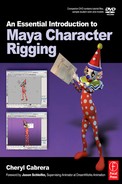Creating Your First Biped Character: Facial Expressions
![]() Former Student Spotlight: Katie Folsom
Former Student Spotlight: Katie Folsom
![]() Blend Shapes as an Approach to Creating Facial Expressions
Blend Shapes as an Approach to Creating Facial Expressions
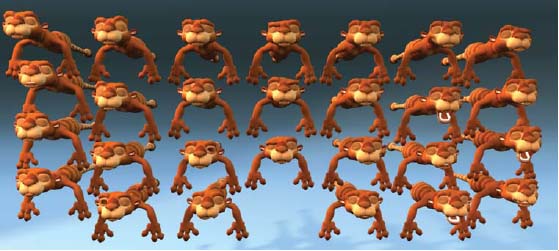
The many faces of Tiko, by Josh Burton.

A few facial expressions of Tiko in Much Ado About Breakfast, by Josh Burton (2003).
Former Student Spotlight: Katie Folsom
The one thing that I’m still finding out – especially with rigging and animation – is that there will always be surprises, no matter how much you think you have things planned out. There is no way to avoid them, especially in the beginning. The good news is they do become less over time. However, I feel the best way to keep the number of surprises to a minimum is through consistency, organization, and just understanding. It sounds like a no-brainer, but you would be surprised at how easy it is to get lost in the process. Whether it’s your naming conventions, the order in which you work … you will find that anything you might have avoided in an earlier stage will not leave you alone unless the problem is solved right away. In the end it can really affect the quality of your work.
I think I had the most trouble with my blend shapes. I thought that I could just fix them when I got to that part of the animation, and I just really wanted to move on. Without going into too much detail, I ended up doing the second half of my project twice. Time I could have been spending on fine tuning and making my animation look better. Another thing I had to spend a lot of time getting right was rigging the hands. I had 10 fingers and a lot of hand movement in my first short so they had to be right. The orientation of the joints and the joint placement … it was something I had to keep going back and forth with. A lot of it is trial and error. With that being said, take the time to really understand what it is you’re doing and whether or not it’s the best way. Don’t just go through the motions and think it’s going to work to its full potential. Don’t let the technical part of the process affect the artistic part. If you do breeze through it the first time, you got lucky.
From 1999 to 2001, Katie Folsom was a student at the University of Cincinnati in DAAP and graduated from Savannah College of Art and Design in 2004 with a BFA in computer art. Her professional experience includes the feature film, “Barnyard,” released August 2006. You can see some of her work at: www.katiefolsom.com.
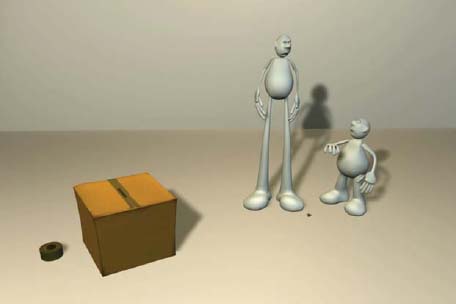
Sticky by Katie Folsom (2003).
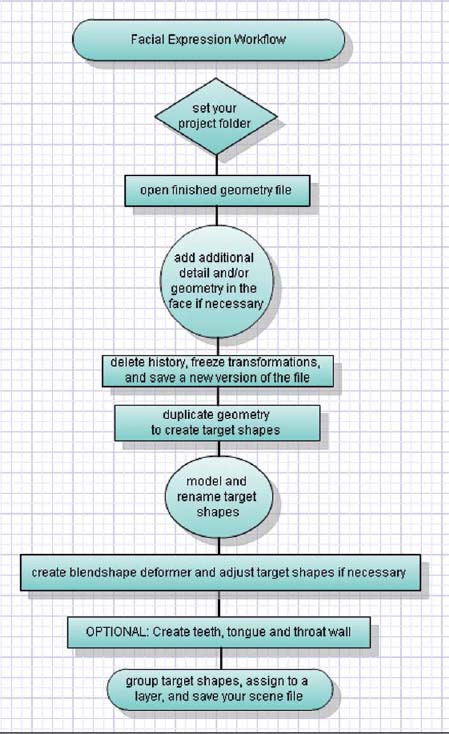
Facial Expression Workflow.
Facial expressions are a crucial part of your character’s ability to communicate. Most of what your character feels will be articulated by using facial expressions. Face language is universal. For example, we can instantly tell when someone is worried, happy, or sad based on the position of their eyebrows, cheeks, and mouth, no matter what language is spoken.

The concept expressions for Bernie, by David Leonard.
Depending on the amount of time allotted to preparing your character’s facial expressions, you can create different levels of complexities. For example, you could create a worried face with eyebrows that are pinched together and lowered, and lips that are slightly pursed. Instead of creating a single worried expression, you could separate the eye and eyebrows as a separate shape from the mouth shape. For even further control, you could create asymmetrical poses for the left and right sides, ending up with four separate shapes, that when combined, create the worried expression.
Now, you might be thinking to yourself, “Why spend time separating these single expressions into four or more partial shapes that need to be combined in order to achieve a single expression?” Well, the answer is fairly simple. When you create independent pieces, you can assemble those pieces with others to create new facial expressions that were not necessarily planned.
The following facial expressions are the ones that I recommend you create. This is a list that I feel gives you the most possibilities with a minimum amount of work. I’ve divided them into eye, nose, and mouth areas. The eyebrows should be broken into left and right, for greater control.
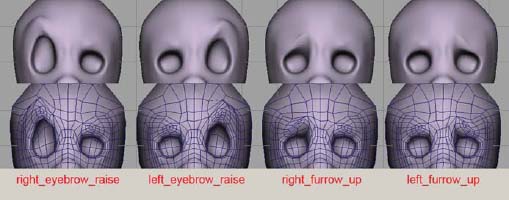
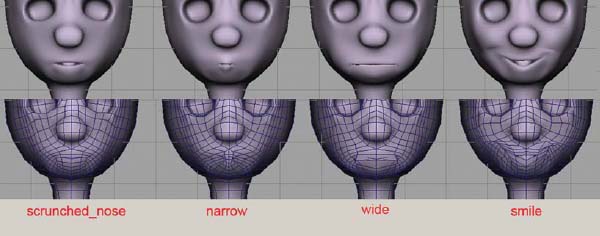
The top image shows the geometry smoothed. The bottom image shows wireframe on shaded on the low poly model, prior to smoothing.
Blend Shapes as an Approach to Creating Facial Expressions
There are two common approaches primarily used when creating facial expressions: blend shape driven poses and joint driven poses. In this chapter, we will be focusing on the former, as the joint driven process assumes you already have an understanding of joints and skin deformers, which we won’t address until later chapters. The joint driven process is the approach used for animation in the gaming field, because at this time, game engines do not support blend shapes.
A blend shape is a deformer that changes the shape of one piece of geometry to look like the shape of another. This deformer has also been referred to as a morph, because its concept is based on a metamorphosis. Blend shapes can be used for pretty much any type of morphing. While this chapter will focus on facial expressions, they can also be used in the rest of the body, such as muscle motion and making sure the body geometry bends appropriately in areas such as elbows and knees, a process known as corrective blend shapes.
![]()
Once you do understand joints and the skinning process, you can actually use joints to create your blend shapes.
Before creating blend shapes, it is extremely important to finalize the geometry. Your finished geometry is considered your base shape. The base shape is duplicated into the target shapes (as many times as necessary), and each target shape is remodeled (with certain limitations) to reflect the desired facial expressions. Blend shapes work by comparing the positions based on the order of individual points in the surface (points such as vertices or CVs). Each point is numbered, so if you alter the geometry by adding or subtracting points, the blend shape will no longer work and an error message will be given. For this reason, you must finish the face model before creating blend shapes. The more refined and detailed the facial expression, the more geometry is needed in the area (more isoparms or edges are necessary to provide more CVs or vertices that can be pushed and pulled). However, you can get some basic facial expressions from very simple geometry.
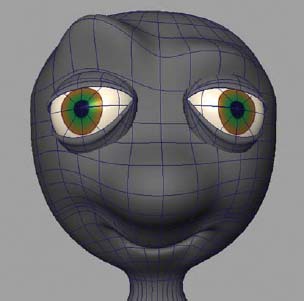
A NURBS head with simple geometry can still be used to create a facial expression.
![]()
NEVER FREEZE TRANSFORMATIONS on blend shapes. You can freeze the base shape BEFORE creating your target shapes. However, once the target shapes are created, DO NOT freeze transformations on the base or target shapes. If you do, the base shape will fly back to the origin when animating.
When modeling your face, it is always best to have geometry that is modeled along the muscle lines of the face. If you did not spend enough time during the modeling process, you may want to devote a little more time now to add adequate geometry before trying to make your facial expressions. It is also important to understand the movement of facial muscles and what effects they have on the face. Be sure to refer to anatomy books for images to study these patterns of muscle placement. The closer you can mimic these patterns, the more accurate your character’s facial expressions will be, providing a level of believability even to the most stylized characters.
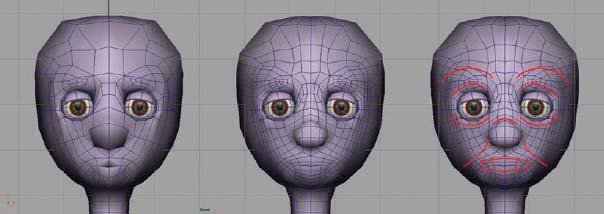
This polygonal face needed more edges to create a more believable series of facial expressions. Understanding facial muscle structure will assist in making these expressions.
Tools Used for Modeling Blend Shapes
The most commonly used tool for modeling blend shapes is the Move Tool – keyboard shortcut (w) or the Scale Tool – keyboard shortcut (r). You can use the move tool in component mode (right mouse buttons, RMB) over the surface or hit (F8) for pushing and pulling points around just as you would when modeling to create the desired shape. Make sure to rename each target shape as they are created. This section focuses on three tools that can simplify much of this process.
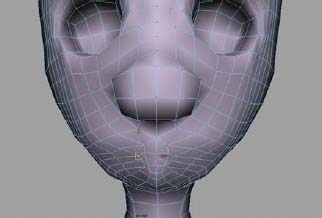
Using the move tool to create pursed lips for a target blend shape.
![]()
You cannot create a blend shape by scaling or moving on the object level.
A change on the object level of the target shape does not affect the base shape.
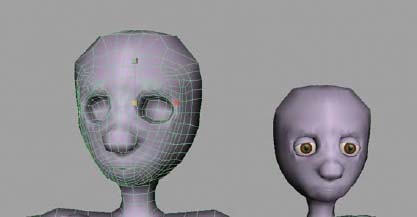
Simply scaling your geometry does not make a deformable object. You must make changes on the component level by selecting the vertices or CV’s first, then scale them.
Soft Modification Tool [Create Deformers > Soft Modification] (It is also found under the tool manipulators).
The soft modification tool is a deformer that allows you to click on an area and push and pull points, much like you do with the move tool, but it affects the surrounding points as well as the point initially clicked. This tool is more intuitive for artists than the move tool, as it simulates the pushing and pulling of clay. The greatest affect is on the area clicked, and the gradual drop off can be adjusted for greater control. Color feedback is turned on by default, which is visually helpful when adjusting the drop off rate. You can also select an area of points (vertices or CVs) and then apply the soft modification, which limits the deformers to only those points. Make sure to open the option box and turn on Preserve history, so that you can modify changes later if necessary.
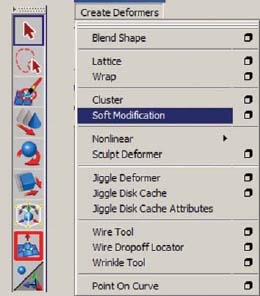
The Soft Modification tool can be found with the Tool Manipulators and in the Animation menu set (F2) under the Create Deformers menu.
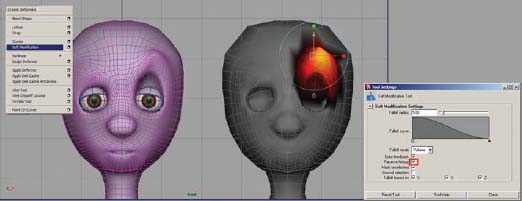
Using the soft modification tool to create an eyebrow raise. Make sure to turn Preserve History ON in the option box before using the tool so that you can adjust the position of the Soft Modification deformer later if necessary.
The Lattice deformer [Create Deformers > Lattice] and the Sculpt Geometry tool [Edit NURBS > Sculpt Geometry Tool – option box], which were discussed in Chapter 2, are also helpful for creating additional facial expressions.
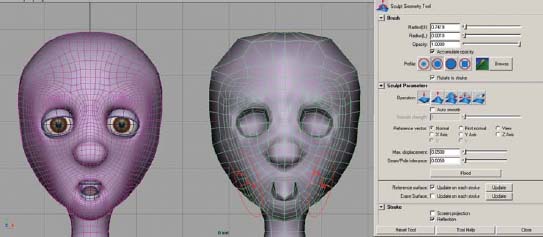
After moving vertices in place, the sculpt geometry tool can be used to help shape the open mouth position.
Add Blend Shapes [Create Deformer > Blend Shape]
Once the target shapes (facial expressions) have been created, you must apply them to your base shape (neutral pose) using the blend shape deformer. Holding down the shift key, click select on each target shape(s) then select your base shape. (Make sure they have been renamed appropriately, i.e. smile, frown, left_eyebrow_raise, etc. BEFORE applying the deformer.) When defining a blend shape, the base shape MUST be selected last. To test your blend shapes, open the blend shape animation editor [Window > Animation Editors > Blend Shapes]. This will open up the blend shape editor which has a slider for controlling the movement between the shapes. You can also access the blend shape by clicking on the input node in the channel box and changing the value of the field. This attribute is accessible through the Attribute Editor [ctrl+a] as well. It is also a really good idea to set up another control system for your blend shape sliders, which will be covered later in Chapter 7 of this book, so that they can be animated more easily.

The blend shape deformer can be found on the Deformation shelf.
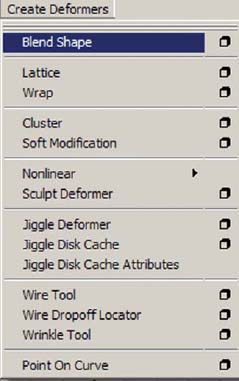
The blend shape deformer can be found in the Animation menu set (F2) on the keyboard under the Create Deformers menu.
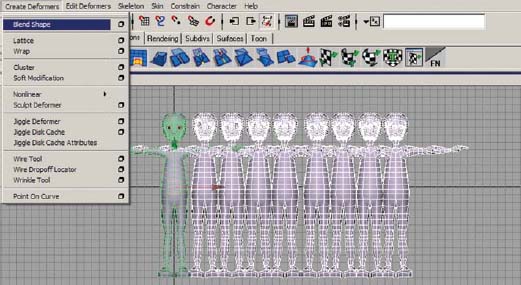
Creating the blend shape deformer.
![]() Make sure to rename each target shape BEFORE applying the deformer. If you relabeled them afterwards, Maya would not recognize them and your target shapes would not affect the base shape.
Make sure to rename each target shape BEFORE applying the deformer. If you relabeled them afterwards, Maya would not recognize them and your target shapes would not affect the base shape.
![]()
Do NOT delete history on the geometry after the blend shape deformer has been created. Doing so will delete the blend shape deformer. If this happens, you will have to recreate the deformer again.
![]()
Have I mentioned? NEVER freeze transformations on Blend shapes!
Update Topology on Blend Shapes [Edit Deformers > Bake Topology to Targets]
This is a relatively new tool in Maya, as it was introduced to allow for topology changes to the base shape to be updated on the pre-existing target shapes. For example, if more edges needed to be added to create a particular expression, the existing target shapes would need to be applied to the base shape using [Create Deformers > Blend Shape]. Once the existing target shapes work, the base model can be modified (i.e. more geometry added). This command will pass the modifications on to the target shapes.
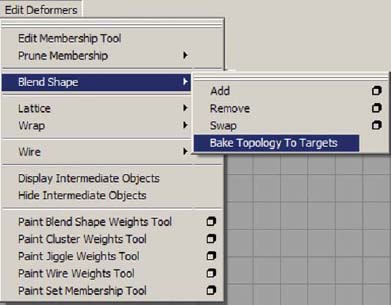
Bake Topology to Targets can be found in the Animation menu set (F2) on the keyboard under the Edit Deformers menu.
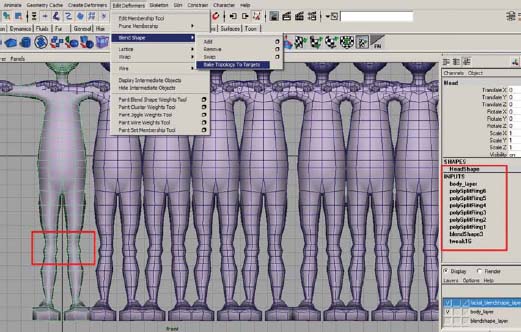
Adding additional edge loops around the knees adds construction history.
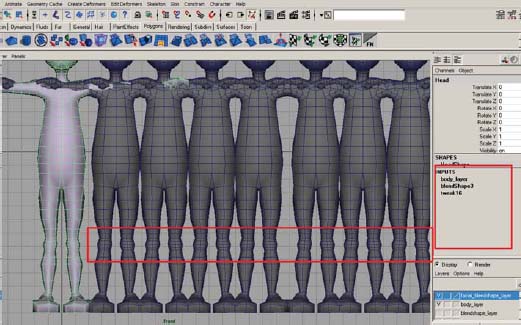
Bake Topology to Targets updates the target shapes and removing the associated construction history.
![]()
Not all changes to the geometry will work reliably. For example, you cannot delete faces. Therefore, make sure to incrementally save your work, in case of unpredictable results. Bake topology to targets works best with polygonal geometry.
When working with deformers, especially for use with animation, it is important to know that history affects how a particular deformer affects the geometry. Multiple deformers can be applied to the same piece of geometry, and some deformers have to be applied before others, in order to get the desired result. The order in which deformers are created makes up the deformation order for that object, and Maya evaluates them in that order. Creating deformers out of order is not a problem, as the deformation order can be changed.
When creating characters for animation using blend shapes, the blend shape deformer should be the first deformer created, as Maya must evaluate blend shapes before any other deformer. If not, bizarre things happen, like your character’s geometry will fly off of its skeleton. Remember, if you apply blend shapes after skinning, you must change the deformation order so that the blend shapes are evaluated first.
To change the deformation order, with the geometry selected, RMB (right mouse button) over the base shape geometry and, from the popup marking menu, select [Inputs > All Inputs]. This opens up a window name List of Input Operations that shows you a list of the deformers currently affecting this surface. Use the MMB (middle mouse button) button to click and drag the blend shape below any other deformers listed, or to the bottom of the list. This reorders the deformers. Maya evaluates the deformers on the list from the bottom up.
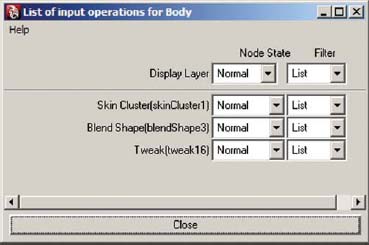
The list of input operations that shows the correct order for the skin deformer and blend shape inputs.
![]()
Just in case you forget, NEVER FREEZE TRANSFORMATIONS on blend shapes! Have you figured out how important this is yet?
3.1 Facial expressions are crucial for your character’s ability to communicate.
3.2 It is best to divide each facial expression into parts that create the expression. Separating each expression into eyes, nose, and mouth areas provides a palette of options that can be combined while animating. The minimum suggested are the following:
eye target shapes:
left_eyebrow_raise
right_eyebrow_raise
left_furrow_up
right_furrow_up
left_furrow_down
right_furrow_down
left_squint
right_squint
nose target shapes:
scrunched_nose
nose_up (optional)
mouth target shapes:
narrow_pucker
wide
smile (which includes raising the cheeks)
open (which includes dropping the jaw)
sad_frown
3.3 There are two basic approaches for creating facial expressions: blend shapes and joint driven.
3.4 Blend shapes are a deformer that change geometry shapes using a morph process.
3.5 Once you understand joints and skinning, you can use joints to create the blend shapes.
3.6 Before creating blend shapes, it is extremely important to finalize the geometry.
3.7 You can get basic facial expressions from very simple geometry.
3.8 Never freeze transformations on blend shapes!
3.9 Research muscle structure for facial expressions as an aid to creating believable motion.
3.10 The same tools used for modeling your character can be used to model the blend shapes.
3.11 All geometry changes must be on the component level when modeling blend shapes.
3.12 The most common tools for modeling blend shapes are the following: the move tool (to move components such as points), the soft modification tool, the lattice deformer, and the sculpt geometry tool.
3.13 Be sure to label each target shape as they are created.
3.14 Deleting history on target shapes is unnecessary.
3.15 To create a blend shape, first select all target shapes, then shift select the base shape.
3.16 Do not delete history on that base shape geometry after the blend shape deformer has been created. Doing so will delete the blend shape deformer.
3.17 If there is a need for more geometry while creating the blend shapes. It is possible to add more divisions to the base shape and then update the topology to blend shapes that have already been applied. However, this process is not always reliable. Therefore, be sure to finalize your geometry before modeling your blend shapes.
3.18 As always, there is a certain workflow and order of operations that exists. Blend shapes should be applied before the skinning deformer is applied. However there is a list of input operations that allows the change of deformation order, if necessary.
Assignments: Facial Expressions for a Character
Assignment 3.1: Create Facial Expressions
1. Your finished geometry is your base shape. (This is the neutral pose for you face.) This can be one entire piece of geometry (the whole body) or a separate head. If your head is separated, do NOT combine it (if polygonal) after making your blend shapes, as this will make your blend shape targets not work any longer.
2. Duplicate your base shape 15 times and create your target shapes. Move them above or below your base shape. Rename the target shapes appropriately.
eyebrow target shapes:
left_eyebrow_raise
right_eyebrow_raise
left_furrow_up
right_furrow_up
left_furrow_down
right_furrow_down
left_squint
right_squint
nose target shapes:
scrunched_nose
nose_up (optional)
narrow_pucker
wide
smile (which includes raising the cheeks)
open (which includes dropping the jaw)
sad_frown.
1. Use the following tools to reshape these into the facial expressions: Move tool, scale tool, soft modification tool, sculpt geometry tool, lattice deformer.
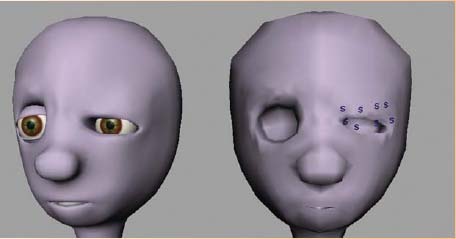
Using the soft modification tool to create the left_squint eyebrow target shape. It may take several clicks of this tool to get the desired shape.
![]()
The soft modification tool can be used effectively to create all of the eyebrow target shapes, as well as the nose target shapes. To create the mouth shapes, you will probably need to start with the move and scale tools, then refine the shapes with the sculpt geometry tool.
Assignment 3.2: Create the Blend Shape Deformer
1. Select your Target shapes then shift select your base shape.
2. Select Create Deformer [Create Deformers > Blend Shape].
3. In the Layer Editor of the Channel Box, create a new layer. Double-click on the new layer (layer1) and rename this layer blend shape_layer, then click save. Shift select all of the target shapes you have made, RMB click and hold on top of the blend shape_layer and choose Add Selected Objects. To make the objects invisible, click on the V (visibility) to turn it off.
![]()
When defining a blend shape, the base shape MUST be selected last.
After creating the blend shape deformer, you should test the blend shape:
1. Select [Windows > Animation Editors > Blend Shape]. This will open up the blend shape editor which has a slider for controlling the movement between the shapes.
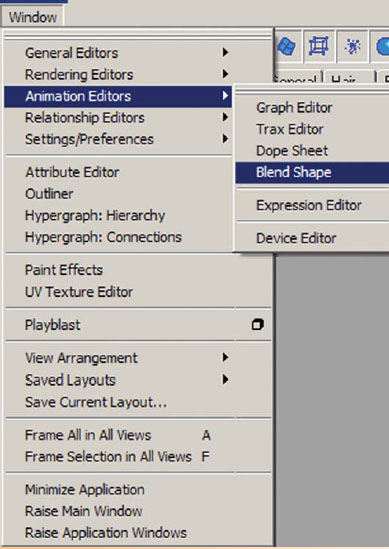
Opening the blend shape editor.

The blend shape editor.
2. You can also access the blend shape by clicking on the input node in the channel box and changing the value of the field. This attribute is accessible through the Attribute Editor as well.

The attribute editor and channel box showing the blend shape attributes.
3. Make changes as necessary to the target shapes. You can update them as needed and they will automatically update the deformer. To make it easier to make changes, move the target shape right next to your base shape and make the changes with the slider turned on.
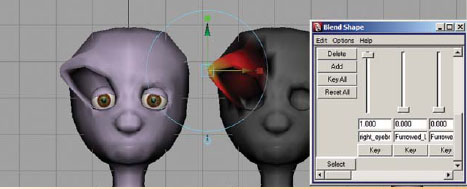
If you push the slider up, you can make adjustments to the target shape and see the changes automatically on the base shape.
Assignment 3.3: Create Teeth and Tongue (Optional)
If you plan on opening your character’s mouth for any facial expressions or plan to have your character speak, you will need to model teeth and a tongue. This can be done with not much detail.

The teeth and tongue front view and back view.
The tongue is simply a sphere created on the Z-axis and reshaped using a lattice. The teeth can be made by creating a profile curve in the front view, performing a revolve and changing the start sweep of the revolve to 180 in the channel box.
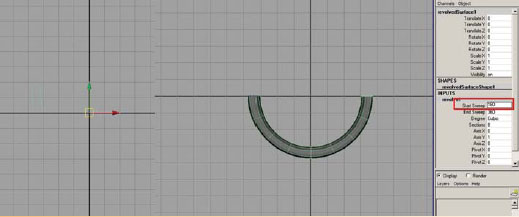
The profile curve of the teeth in the front view and the top view showing the revolve start sweep beginning at 180.
A lattice deformer can be used to create the narrower shape. The teeth can be duplicated and flipped to create the bottom row. Be sure to also add a shaped plane to act as the throat wall.
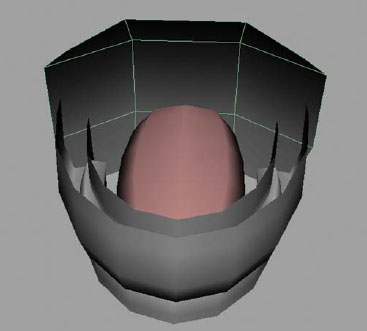
A shaped plane added for the throat wall.
